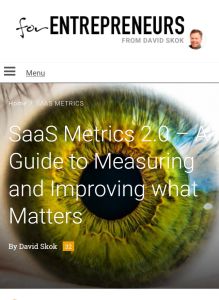
David Skok
SaaS Metrics 2.0
A Guide to Measuring and Improving What Matters
For Entrepreneurs, 2018
Was ist drin?
SaaS enterprise performance depends on a few key metrics – and customer retention comes first.
Recommendation
Software as a service (SaaS) executives face a different set of challenges than their counterparts at more traditional enterprises and need a different set of metrics. To help subscription businesses evaluate viability, make stop-or-go decisions, and grow faster and bigger, venture capital investor and serial entrepreneur David Skok, writing on his blog forEntrepreneurs, offers a comprehensive article describing the critical metrics for subscription businesses and ways to improve them. Although long and at times complicated, Skok’s discussion ranks as a must-read for SaaS executives and investors.
Take-Aways
- Software as a service (SaaS) executives should focus on customer retention above all, because profits, growth and success depend on long customer lifetimes.
- SaaS businesses experience losses and sometimes cash flow problems in their early years, because it takes time to recover investments in customer acquisition.
- Usually, a viable SaaS business will have an average customer lifetime value at least triple the typical cost to acquire a customer (CAC), and the business will be recovering the CAC in less than 12 months.
- SaaS executives should pay close attention to churn, because it limits how fast the business can grow and how big it can grow.
- Levers that SaaS businesses can pull to boost growth include churn, product, funnel metrics, sales metrics and pricing.
Summary
Software as a service (SaaS) enterprises – and other subscription businesses –differ from traditional businesses in that their revenue depends primarily on customer longevity. SaaS executives should focus on customer retention above all else – because their profits, growth and overall success depend on it. The critical metrics for SaaS businesses reflect customer lifetime value (LTV), typical cost to acquire a customer (CAC), churn – the percentage of customers that leave each month or year – and monthly or annual recurring revenues (MRR or ARR).
“Traditional business metrics totally fail to capture the key factors that drive SaaS performance.”
It takes time for an SaaS business to recoup investments in customer acquisition. This means that during times of accelerated growth, especially the start-up phase, the company will experience a P&L trough: financial losses and possibly a cash-flow pinch. The best way to weather this phase? Understand it for what it is, and avoid the mistake of slowing down growth. A viable business will recover as the new customers age into paying for themselves. How do you evaluate the viability of an SaaS enterprise? Experience shows that most healthy SaaS businesses have an LTV at least triple their CAC and that the firms recover CAC in no more than 12 months. Net bookings for a period (per month for MRR or per year for ARR) equals new bookings of customers added that period, less the lost bookings of customers that canceled that period, plus expansion (current customers’ purchases of expanded subscriptions). HubSpot executives track net MRR and churn numbers daily and make course corrections to meet monthly and quarterly goals.
“If your net revenue churn is high (above 2% per month), it is an indicator that there is something wrong in your business.”
Churn looms as the largest factor in an SaaS business’s success or failure. Churn dictates both how fast and how big a company can grow. Executives can boost the company’s potential size and growth rate by reducing churn and increasing new bookings and/or expansion revenue. In addition to churn, major levers that SaaS businesses can pull to pump up growth include product (refine your value proposition, re-examine your market), funnel metrics (crank up the raw lead numbers or conversion rates), sales metrics (look at sales productivity, capacity and retention) and pricing (consider multi-axis pricing or product modules).
About the Author
Venture capital investor and serial entrepreneur David Skok writes at his blog, forEntrepreneurs.
This document is restricted to personal use only.
My Highlights
Did you like this summary?
Read the articleThis summary has been shared with you by getAbstract.
We find, rate and summarize relevant knowledge to help people make better decisions in business and in their private lives.
Already a customer? Log in here.





















Comment on this summary